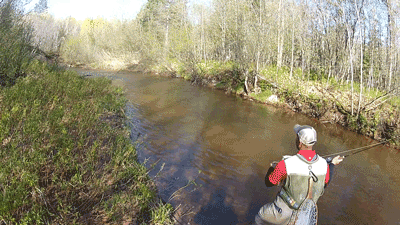![News & Tips: How to Make the False Cast in Fly Fishing [Video]...](http://afd-production-eru2ractomp34-gjdjeybzcubvfrgz.z01.azurefd.net/sites/default/files/styles/large/public/images/news-tips/89601bda48977e8139a1ddcf09fa1fd3.jpg?itok=WmMzNKbY)
Casting as a function in fly fishing is a fundamental skill that separates the effective fly fisherman from the ineffective one. While there are many different types of fly-casts that an angler has to master, becoming proficient with the basic techniques involved with positioning the fly, like false casts, can be a benefit to all anglers.
What is the False Cast
The false cast is a specific type of cast that is performed when an angler either wants to change the direction of a cast, change the distance of a cast or dry off a fly. In the very simplest terms, the false cast is a combination of a pickup and laydown cast, except that you keep the line off the water.
One key point to remember is that the longer your fly is on the water, the better your chances are to catch fish. Keep false casting to a minimum — too much action above the water and you chance chasing away spooky fish. If you need to change positions of the fly or lengthen your cast, take the bare minimum number of false casts to accomplish this. At first it might seem tough to limit the amount of false cast you make, but after a bit of practice you will become efficient and purposeful with your false casting efforts.
How to Make a False Cast
 |
| The false cast in fly fishing. |
To break down the process behind the false cast, start out by lifting the rod from the fishing position to the 1 o'clock position with a smooth quick stroke. This upward movement will accelerate the line, lifting it off the water and throwing it into the back cast.
Once the line has entered the back cast (the line has past your casting shoulder) and is beginning to unroll behind you, swiftly move the rod again but this time in a forward motion. This forward stroke from the 1 o'clock position to the 10 o'clock position will pull the line into the front cast (coming over your casting shoulder again but this time to the front of your body).
Combining these two processes, the forward and the backward casting motions together for 1 to 3 strokes, will allow anglers to keep control of the line.
During the false casting strokes, either feed more line into the stroke to achieve greater distance or change the angle of the cast to change the layout target.
If you plan on drying your fly simply speed up the false cast to whip dry the pattern.
Here's a quick video of the false cast:
- 4731 views

